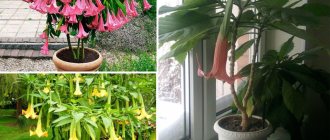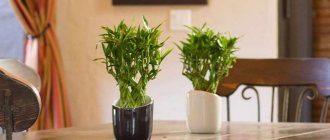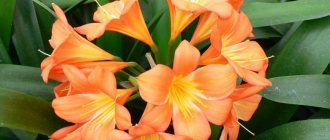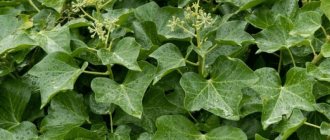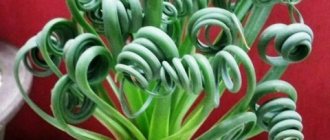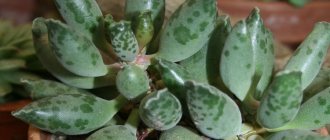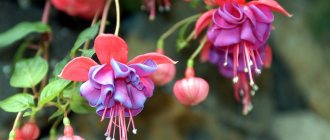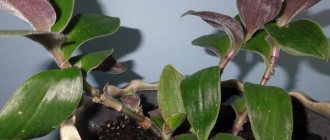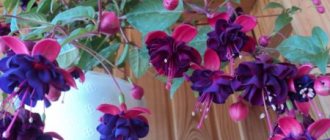Adromiscus is a plant that belongs to the Crassulaceae family. It is a succulent that is just gaining popularity. The reason is that this grass complements the interior well. Looks great both in a cozy apartment and in the office.
Author of the article
Maxim Sverchkov
Professional biologist and breeder with extensive experience and experience.
Description of the plant
Adromiscus is a favorite among gardeners. They are attracted to perennial leaves. And to be more precise, their shape and shade. They are triangular. They can be either green or bright red.
They are quite easy to care for. Therefore, owners can only admire their unusual beauty. Translated from Greek, “adromiscus” means “thick stem.” The height of Adromiscus reaches fifteen centimeters. It was first found in Africa. At the moment, you can meet him both in the south and southwest of this continent.
Possible pests
The most common pests that can bother Adromiscus are mealybugs and vine weevils. While caring for these beauties, take the time to inspect their leaves for natural predators. These days, people tend to try less toxic chemicals to keep their plants clean. Neem oil, when used as a fertilizer or in a potting mix, repels insects, making the plant temporarily unattractive to them.
Aphids are not a big problem for succulents, especially if they are kept a little dry. But sometimes you can see groups gathering on more lush plants. They can be dealt with using a soap solution or just regular insecticides.
Adromiscus species
There are quite a few different types. The data is different. While some scientists count fifty species, others talk about seventy. The difference is as much as twenty species.
Only a small part has been cultivated. Before purchasing this perennial plant, you need to carefully study all the characteristics and decide which type is best for you.
The most popular types will be discussed here.
Adromiscus Cooper
This grass is very small in size. Its foliage is a dark green shade. Large brown spots can be seen. If you properly care for the plant, its leaves will be glossy. At the same time, they will be quite smooth to the touch. The edge is usually uneven. Length no more than five centimeters. During the flowering period, flowers appear, the maximum size of which reaches one and a half centimeters. They have 5 petals. All are adjacent to the peduncle. It is long and thick.
Adromiscus Poelnitz
It reaches ten centimeters in height. This is a branched succulent. Each of the leaves looks like a geometric figure - an inverted triangle. If you look closely, you will notice that there are fibers at the edge of almost every leaf. During flowering, very large inflorescences appear. The length of each reaches forty centimeters. Small flowers are formed from the inflorescences. They are white or green in color.
Adromiscus schuldianus
They differ from other representatives in the color of their leaves. They are green, however, the closer to the edge, the more red they become. Their shape is ovoid - that is, similar to an egg. The edge of each leaf is pointed. A photo of Adromiscus will show how unusual this plant is.
Adromiscus spotted
The stem of this succulent is more stable than that of other representatives of this family. Grows up to ten centimeters in height. The foliage is round in shape. On the greenery you can distinguish spots of purple or red. The width of each leaf reaches three centimeters, and the length – five. The flowers that appear during the flowering period are a spike. Their borders are usually dark red.
Adromiscus tripeculi
The length varies from eight to ten centimeters. Unlike the stems, which are short, the leaves grow quite elongated. They have sharp edges. On a green background you can see burgundy spots. The width of the leaf varies from three to four centimeters, and the length - from four to five.
Adromiscus cristatus
The second name of this perennial plant is Adromiscus comb. It is slightly larger than Adromiscus tripistillate. It reaches fifteen centimeters in height. A distinctive feature of the succulent is the wavy edge of the leaves. The shape of the sheets is similar to inverted triangles, each of which is a light green shade. If you look closely, you can see that each plant has white fibers. The length of the leaves varies from two to five centimeters, and the width reaches two and a half centimeters. The flowers are a regular white shade. They differ from the flowers of other members of this family. After all, there is a barely noticeable pink stripe along the edge.
Main types
Adromiscus cristatus
This compact succulent does not exceed 15 centimeters in height. Young shoots are erect, but with age they become drooping or creeping, and they contain a large number of reddish aerial roots. The pubescent, convex, short-petioled leaves are collected in rosettes. The dark green leaf blades have a wavy edge. They reach a width of 5 centimeters, and such leaves are also a centimeter thick. The greenish-white flowers have a pink edge.
Cooper's Adromiscus (Adromischus cooperi)
It is also a compact succulent whose stem is not only very short, but also branched. Green, oval, glossy leaves have brownish-red spots on the surface. The edges of the leaves are wavy, and they can reach 5 centimeters in length. The long inflorescence has the shape of a spike. Tubular greenish-red flowers reach 1.5 centimeters in length and have a pink, white or purple edge.
Poellnitz's Adromiscus (Adromischus poellnitzianus)
This miniature succulent does not exceed 10 centimeters in height. The pale green shoots branching from the base are convex and smooth in the lower part, while they gradually expand upward and turn into a flattened wide part with a wavy edge. There are barely visible whitish hairs on the surface. On an inflorescence of forty centimeters in length there are not very attractive flowers.
Spotted Adromiscus (Adromischus maculatus)
These are weakly branching small succulents that reach a height of only 10 centimeters. There are red spots on the surface of the dark green leaves. The oval or round leaf plate can reach 5 centimeters in length and 3 centimeters in width. The color of the flowers is brownish-red.
Plant propagation
This perennial plant reproduces using vegetative organs.
The vegetative method is quite simple. All you need to do is carefully cut off the leaves of the adroiscus. And then leave them for a couple of hours in a dry place. At this time, you can prepare the substrate. If you have all the necessary materials, then you can create soil at home.
To do this, you need to take one part of river sand, add the same amount of peat and add the same amount of vermiculite. If there are no ingredients, then you need to purchase a mixture in the store that is intended for succulents. Once everything is ready, the leaves can be planted.
The root system will begin to develop in about four weeks.
The pot in which the adromiscus is located should be quite spacious. As soon as it becomes noticeable that the succulent does not have enough space, it must be transplanted into a new container. Just like the planting process, transplantation is carried out in the spring. You need to be very careful with this procedure, because the plant has quite fragile roots. It is important not to damage them.
Before replanting, you need to lay drainage at the bottom of the new container, then pour out the prepared mixture and only then replant the adromiscus.
There is a risk of rotting. To prevent the appearance of rot, the perennial does not need to be deepened when planting.
Reproduction
The plant can be easily propagated using cuttings or individual leaves. Fallen leaves take root easily and begin to grow quickly.
It is better to propagate the flower in late spring.
To do this, you need to remove 3-4 old leaves near the top and put them on a sheet of newspaper to dry a little. Then place them on the surface of the ground with the petioles down. The tops can be placed on the edge of the pot or sprinkled with soil on top so that they are in a stable position.
Leaves should not be watered until roots appear.
Young shoots will form directly from the base of the leaves. Old leaves can be removed when they are completely withered and dry.
Adromiscus care
This plant does not have strict care requirements, so caring for Adromiscus is not that difficult. Firstly, it requires constant lighting. In this case, you must carefully ensure that the leaves do not fall into direct sunlight. After all, burns can form.
The temperature in the room should be thirty degrees. In cold weather the temperature can drop to ten degrees. If the temperature is lower, the plant will most likely die.
Adromiscus does not really like spraying. Water can cause rot. It will also increase the risk of burns on the leaves. If there are damaged parts, they must be removed immediately.
4.Adromiscus care at home
4.1.Watering
The succulent tolerates drought well, like other representatives of this type of plant. Water regularly during the warm season, but make sure the soil dries out between waterings. Reduce watering in the fall and keep the humidity low enough in winter to keep the leaves from shriveling. Drain off excess moisture that has accumulated in the tray a few minutes after watering.
↑ Up,
4.2.Maintenance of the house, wintering of Adromiscus
As it develops, the center of the plant becomes exposed. Free it from the side cuttings and throw away the central part, and root the side shoots. In the warm season, take the plant outside.
↑ Up,
4.3. Soil composition
The composition of the soil for succulents is approximately the same; the main requirement is its moisture permeability. Any well-drained soil, sandy substrate with a very small amount of organic matter (peat, humus) will do. Ideal drainage is essential.
↑ Up,
4.4. Temperature conditions
Tolerates cool temperatures in winter if kept dry. Avoid getting water on the leaves in winter as this will cause the plants to rot. Minimum temperature 5 ° C (withstand short-term frosts down to -7 ° C if located in dry soil).
↑ Up,
4.5.Lighting
In strong light, the growth remains compact, and the leaves acquire a reddish-burgundy hue; when grown in partial shade, the plants become loose and elongated. Variegated varieties require a lot of sun; in the shade their leaves turn green. Unfortunately, the main growth period occurs in the autumn-winter period, when lighting is poor, while the summer months are mainly devoted to flowering.
↑ Up,
4.6.Fertilizer
Once a month, fertilize cacti with a high potassium content. During the dormant period, when plants stop their development, feeding should be stopped.
↑ Up,
4.7.Spraying
It tolerates even very dry air and does not need spraying. In autumn and winter, the air around the plant should be dry.
↑ Up,
Problems when growing Adromiscus
This is a strong plant that is resistant to various pests and diseases of Adromiscus. However, in some cases, you can see, for example, spider mites on the leaves. You can first walk over the leaves with a damp cloth. However, the best control method is the use of insecticides.
If the leaves are cracked, this means that you need to reduce the dose of watering. If you don't do this soon, the roots will begin to rot.
Another article described: Agave
Diseases and pests
The plant is only threatened by root rot caused by frequent watering and the use of cold water. The disease manifests itself by wilting of the leaves and the appearance of dark spots on the stem.
Treatment:
- replanting the succulent in new soil;
- pruning damaged roots;
- treatment of healthy parts of the plant with a solution of potassium permanganate, Fitosporin.
Adromiscus can be parasitized by scale insects, spider mites, and aphids. Insecticides used against insects are: Aktaru, Stop Mite, Actellik.
Care
All varieties of Adromiscus are undemanding in care, despite their tropical origin
Although this tropical succulent is unpretentious, certain care rules must be followed. These include:
- Watering should be regular and moderate, without creating swampiness. It is important that the top soil layer does not dry out completely. This applies to the spring-summer period. And in winter, the frequency of watering is reduced to once a month. The succulent should be watered exclusively with settled water at room temperature. Since Adromiscus tends to accumulate moisture in the leaves, there is no need to spray the crown.
- Fertilizing is required throughout the growing season (March - September) once every 25-30 days. To do this, use factory-made mineral mixtures intended for cacti and succulents. From autumn to spring, they stop feeding the plant.
Adromiscus does not need pruning or shaping. Even after flowering, the buds cannot be picked for 2–3 weeks. Wait until they and the stems dry. Only after this they are cut off with a sharp instrument.
Planting and transplanting
The purchased plant is immediately transplanted into a larger pot and placed in a cool, shaded room. For the first 3–4 days, the new baby is not watered and not disturbed much, which allows him to quickly adapt to the new place. Then the plant is moved to a well-lit windowsill and little by little they begin to water it.
Adromiscus transplantation is carried out using the transshipment method.
Adromiscus is transplanted as the roots grow, when they become cramped in the old container . Usually this procedure is resorted to once a year - in the spring (if there is a need for it). Proceed as follows:
- 2–3 days before the planned transplantation, the flower is completely stopped watering.
- A 5 cm thick layer of drainage is poured onto the bottom of the planting container. Small stones are suitable for this. Soil is poured on top of them.
- Carefully dig around the perimeter of the plant, adhering to the edge of the pot. This technique helps protect the roots from damage.
- They remove the root ball along with the soil, transfer it to a new place and bury it. At the same time, they try not to deepen the stem too much.
After planting, Adromiscus is not watered for the next few days.
Table: errors in care and ways to correct them
| Manifestation of the problem | Causes | Correction Methods |
| Yellowing and falling of old foliage | Normal phenomenon | Does not require any action |
| Intense yellowing and drying of leaves | Contact with water, which leads to burns | Create shading for the plant |
| Sheet plates are cracking | Lack of moisture | Normalize the watering regime |
| The shoots become very elongated and thin, and spots disappear on the leaves. | Not bright enough lighting | Change the location of the flower |
Adromiscus transplant
Adromiscus is transplanted in early spring before the start of a new growing season. Do this as needed - when the roots begin to protrude through the drainage holes or the top part grows.
Choose a wide and shallow pot; place a layer of drainage on the bottom (expanded clay, pebbles, broken bricks, pieces of foam plastic, fine gravel, etc.) in a layer up to ¼ of the total volume.
The soil needs to be light, loose, and well permeable to water and air. Take universal soil for succulents and cacti as a base, add pieces of charcoal and coarse sand to it. Transfer it along with the earthen clod, and after replanting, water it a little at a time so that the roots do not start to rot.
Adromiscus: flower propagation
The best way to propagate Adromiscus is by cuttings. For this crop, cuttings are leaves separated from the stem in spring. They must be kept in a dry and dark room for several hours. This will allow the planting material to dry.
Then the cuttings can be planted in small containers filled with coarse river sand or vermiculite crystals.
Another option for a mixture for planting adromiscus cuttings is a combination of sand and ready-made soil for cacti and succulents. As a rule, within a month after planting, the cuttings form an independent root system.
Disease prevention and pest protection
Of the harmful insects, the greatest danger to Adromiscus are aphids, spider mites and felt insects, also called mealybugs. It is necessary to carry out regular inspection of adromiscus in order to detect signs of pest damage in time.
It is also recommended to remove dry plant parts as soon as they are discovered. You can cope with pests using insecticides, which are sold in specialized stores.
Description
Adromiscus is a genus of low-growing, slow-growing succulents belonging to the Crassulaceae family.
The name of the plant comes from Greek words meaning “thick stem.” Indeed, Adromiscus forms a thick, short, low-branching stem lying on the ground. It is densely covered with hairs, which are essentially aerial roots and serve to additionally capture moisture from the air. The leaves are sessile, succulent, with wavy edges. In many species they are decorated with bright spots and streaks. In summer, the plant develops a thin, long peduncle, at the top of which a spike-shaped inflorescence develops. The flowers are small, tubular, brightly colored.
The plant is extremely unpretentious, compact and durable. Adromiscus is perfect for growing in a cactus garden and in combination with other succulents.
